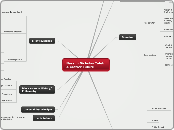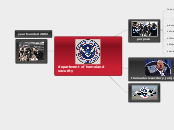Historical and Social Science Skills Analysis - Historical Research, Evidence, and Point of View 3: Students evaluate major debates among historians concerning alternative interpretation of the past, including an analysis of author's use of evidence and the distinctions between sound generalizations and misleading oversimplifications.
11th Grade History Content Standards Framework
Goal of Skills Attainment & Social Participation
Basic Study Skills
CCSS Reading Standards for Literacy in History Grades 11-12 9: Integrate information from diverse sources, both primary and secondary, into a coherent understanding of an idea or event, noting discrepancies among sources.
CCSS Reading Standards for Literacy in History Grades 11-12 2: Determine the central ideas of information of a primary or secondary source; provide an accurate summary that makes clear the relationships among the key details and ideas.
CCSS Writing Standards for Literacy in History Grades 11-12 8: Gather relevant information from multiple authoritative print and digital sources, using advanced searches effectively; assess the strengths and limitations of each source in terms of the specific task, purpose, and audience; integrate information into the text selectively to maintain the flow of ideas, avoiding plagiarism and over reliance on one source and following a standard format for citation.
Critical Thinking Skills
CCSS Reading Standards for Literacy in History Grades 11-12 8: Evaluate an author's premises, claims and evidence by corroborating or challenging them with other information.
CCSS Writing Standards for Literacy in History Grades 11-12 7: Conduct short as well as more sustained research projects to answer a question (including a self-generated question) or solve a problem; narrow or broaden the inquiry when appropriate; synthesize multiple sources on the subject, demonstrating understand of the subject under investigation.
CCSS Writing Standards for Literacy in History Grades 11-12 1e: Provide a concluding statement or section that follows from or supports the argument presented.
Participation Skills
CCSS Writing Standards for Literacy in History Grades 11-12 1b: Develop claim(s) and counterclaims fairly and thoroughly, supplying the most relevant data and evidence for each while point out the strengths and limitations of both claim(s) in a discipline appropriate form that anticipates the audience's knowledge level, concerns, values, and possible biases.
CCSS Writing Standards for Literacy in History Grades 11-12 6: Use technology, including the Internet, to produce, publish, and update individual or shared writing products in response to ongoing feedback, including new arguments and information.
CCSS Writing Standards for Literacy in History Grades 11-12 4: Produce clear and coherent writing in which the development, organization, and style are appropriate to take, purpose, and audience.
Historical and Social Sciences Analysis Skills Historical Research, Evidence and Point of View 4: Students construct and test hypotheses; collect, evaluate and employ information from multiple primary and secondary sources; and apply it in oral and written presentations.
Goal of Democratic Understanding and Civic Values
Civic Values, Rights and Responsibilities
No relative standards
Constitutional Heritage
Standard 11.1.3: Understand the history of the Constitution after 1787 with emphasis on federal vs. state authority and growing democratization.
Standard 11.1.2: Analyze the ideological origins of the American Revolution, the Founding Fathers' philosophy of divinely bestowed unalienable rights, the debates on the drafting and the ratification of the Constitution, and the addition of the Bill of Rights.
National Identity
Standard 11.1.2: Analyze the ideological origins of the American Revolution, the Founding Fathers' philosophy of divinely bestowed unalienable natural rights, the debates on the drafting and ratification of the Constitution, and the addition of the Bill of Rights.
Standard 11.8.2: Describe the significance of Mexican immigration and its relationship to the agricultural economy, especially in California.
Standard 11.10.6: Analyze the passage and effects of civil rights and voting rights legislation (e.g. 1964 Civil Rights Act, Voting Rights Act of 1965) and the Twenty-Fourth Amendment, with emphasis on equality of access to education and to the political process.
Goal of Knowledge and Cultural Understanding
Sociopolitical Literacy
Standard 11.5.4: Analyze the passage of the Nineteenth Amendment and the changing role of women in society.
Standard 11.6.4: Analyze the effects of the and the controversies arising from New Deal economic policies and the expanded role of the federal government in society and the economy since the 1930s (e.g. Works Progress Administration, Social Security, National Labor Relations Board, farm programs, regional developmental policies, and energy development projects such as the Tennessee Valley Authority, California Central Valley Project, and Bonneville Dam).
Standard 11.10.1: Explain how demands of African American helped produce a stimulus for civil rights, including President Roosevelt's ban on racial discrimination in defense industries in 1941, and how African Americans' service in World War II produced a stimulus for President Truman's decision to end segregation in the armed forces in 1948.
Economic Literacy
Standard 11.9.1: Discuss the establishment of the United Nations and International Declaration of Human Rights, International Monetary Fund, World Bank, and General Agreement on Tariffs and Trade (GATT) and the importance in shaping modern Europe and maintaining peace and international order.
Standard 11.6.2: Understand the explanations of the principal causes of the Great Depression and the steps taken by the Federal Reserve, Congress, and Presidents Herbert Hoover and Franklin Delano Roosevelt to combat the economic crisis.
Standard 11.4.5: Analyze the political, economic, and social ramifications of World War I on the home front.
Geographic Literacy
Standard 11.2.6: Trace the economic development of the United States and its emergence as a major industrial power, including its gains from trade and the advantages of its physical geography
Standard 11.8.6: Discuss the diverse environmental regions of North America, their relationship to local economies, and the origins and prospects of environmental problems in these regions.
Standard 11.11.5: Trace the impact of, need for, and controversies associated with environmental conservation, expansion of the national park system, and the development of environmental procession laws, with particular attention to the interaction between environmental protection advocates and property rights advocates.
Cultural Literacy
Standard 11.8.8: Discuss forms of popular culture, with emphasis on their origins and geographic diffusion (e.g. jazz and other forms of popular music, professional sports, architectural and artistic styles.
Standard 11.5.3: Examine the passage of the Eighteenth Amendment to the Constitution and the Volstead Act (Prohibition).
Standard 11.8.7: Describe the effects on society and the economy of technological developments since 1945, including the computer revolution, changes in communication, advances in medicine, and improvements in agricultural technology.
Ethical Literacy
Standard 11.7.5: Discuss the constitutional issues and impact of events on the U.S. home front, including the internment of Japanese Americans (e.g. Fred Korematsu v. United States of America) and the restrictions on German and Italian resident aliens; the response of the administration to Hitler's atrocities against Jews and other groups; the roles of women in military production; and the roles and growing political demands of African Americans.
Standard 11.3.1: Describe the contributions of various religious groups to American civic principles and social reform movements (e.g. civil and human rights, individual responsibility and the work ethic, anti monarchy and self-rule, worker protection, family-centered communities).
Standard 11.10.3:Describe the collaboration on legal strategy between African American and white civil rights lawyers to end racial segregation in higher education.
Historical Literacy
Standard 11.1.4: Examine the effects of the Civil War and Reconstruction and of the industrial revolution, including demographic shifts and the emergence in the late nineteenth century of the United States as a world power.
Standard 11.1.1: Describe the Enlightenment and the rise of democratic ideas as the context in which the nation was founded.
Standard 11.1.2: Analyze the the ideological origins of the American Revolution, the Founding Fathers' philosophy of divinely bestowed unalienable natural rights, the debates on the drafting and ratification of the Constitution, and the addition of the Bill of Rights.
United States History and Geography: Continuity and Change in the Twentieth Century
In 11th grade, student with examine major turning points in American history. There is an emphasis on two majors themes: the nation's beginnings and the industrial transformation of the new nation.









